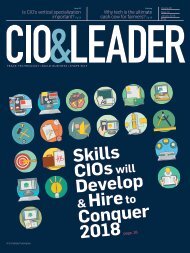white_paper_on_data_protection_in_india_171127_final_v2
Create successful ePaper yourself
Turn your PDF publications into a flip-book with our unique Google optimized e-Paper software.
(i)<br />
Balanc<strong>in</strong>g the issue of children lack<strong>in</strong>g the legal competence to provide valid c<strong>on</strong>sent to<br />
<strong>data</strong> process<strong>in</strong>g activities with the fact that children c<strong>on</strong>t<strong>in</strong>ue to use a large number of<br />
<strong>on</strong>l<strong>in</strong>e services<br />
Under the Indian C<strong>on</strong>tract Act, 1872, a pers<strong>on</strong> is c<strong>on</strong>sidered competent to c<strong>on</strong>tract as l<strong>on</strong>g as<br />
she is no l<strong>on</strong>ger a m<strong>in</strong>or (above the age of 18). However, it may not be possible to prevent<br />
children from access<strong>in</strong>g any <strong>on</strong>l<strong>in</strong>e service <strong>on</strong> this basis. As discussed above, children use<br />
many <strong>on</strong>l<strong>in</strong>e services, access websites, and have social media accounts. Prior to us<strong>in</strong>g these<br />
services, the child will have to c<strong>on</strong>sent to the terms of use and notice of the websites.<br />
Websites attempt to circumvent this issue by seek<strong>in</strong>g the parent‘s c<strong>on</strong>sent <strong>on</strong> behalf of the<br />
child if the child is below the age of 18. However, other countries recognise that rely<strong>in</strong>g<br />
solely <strong>on</strong> parental c<strong>on</strong>sent for all children below the age of majority might have a chill<strong>in</strong>g<br />
effect <strong>on</strong> the child‘s opportunity to freely use the Internet as a medium of self-expressi<strong>on</strong>,<br />
growth and educati<strong>on</strong>. It also does not take <strong>in</strong>to account that as a child becomes older, she<br />
ga<strong>in</strong>s the maturity and capacity to understand the purposes for which her <strong>in</strong>formati<strong>on</strong> may be<br />
used, and so should not be solely reliant <strong>on</strong> a parent‘s c<strong>on</strong>sent. The UK developed a test to<br />
gauge the capacity of a child to understand the c<strong>on</strong>sequences of what she is agree<strong>in</strong>g to <strong>in</strong> the<br />
absence of a parent‘s c<strong>on</strong>sent, with respect to medical decisi<strong>on</strong>s. 425 Perhaps there is a need to<br />
develop a similar test <strong>in</strong> order to develop an alternative model for child‘s c<strong>on</strong>sent generally<br />
with respect to <strong>data</strong> process<strong>in</strong>g, though the form that the test will take <strong>in</strong> India‘s c<strong>on</strong>text.<br />
(ii)<br />
Difficulty <strong>in</strong> determ<strong>in</strong><strong>in</strong>g which websites and entities must comply with the additi<strong>on</strong>al<br />
<strong>data</strong> protecti<strong>on</strong> requirements to safeguard children<br />
The <strong>in</strong>tenti<strong>on</strong> beh<strong>in</strong>d creat<strong>in</strong>g a specific protecti<strong>on</strong> regime for services which process<br />
children‘s pers<strong>on</strong>al <strong>data</strong> is clear. However, it is difficult to p<strong>in</strong>po<strong>in</strong>t the exact type of entity to<br />
which it must apply. If additi<strong>on</strong>al <strong>data</strong> protecti<strong>on</strong> safeguards for children are <strong>on</strong>ly applicable<br />
to websites cater<strong>in</strong>g to children, as it is <strong>in</strong> the US, then this scope may be too narrow. This is<br />
because children also comm<strong>on</strong>ly access websites such as Facebook, which is technically not a<br />
―children‘s website‖. If the <strong>in</strong>tended applicati<strong>on</strong> is <strong>on</strong>ly towards commercial websites, or<br />
websites which support <strong>on</strong>l<strong>in</strong>e transacti<strong>on</strong>s, as it is <strong>in</strong> the EU, which also collect <strong>in</strong>formati<strong>on</strong><br />
relat<strong>in</strong>g to a child, then this classificati<strong>on</strong> may also be flawed as many ‗n<strong>on</strong>-commercial‘<br />
websites collect large amounts of <strong>data</strong> relat<strong>in</strong>g to children and generate revenue by way of<br />
their advertisements, track<strong>in</strong>g use patterns and so <strong>on</strong>. Therefore, it may be difficult to draw a<br />
l<strong>in</strong>e as to which websites will need to comply with additi<strong>on</strong>al child <strong>data</strong> protecti<strong>on</strong><br />
requirements.<br />
Additi<strong>on</strong>ally, specific standards need to be established for other n<strong>on</strong>-website based collecti<strong>on</strong><br />
of <strong>data</strong> about children. Schools and other educati<strong>on</strong>al <strong>in</strong>stituti<strong>on</strong>s are gett<strong>in</strong>g <strong>in</strong>creas<strong>in</strong>gly<br />
digitised often deploy<strong>in</strong>g cloud based services and software as a service modules to manage<br />
their operati<strong>on</strong>s. These entities need clear guidance as to the manner <strong>in</strong> which they need to<br />
manage the <strong>in</strong>formati<strong>on</strong> that they are stor<strong>in</strong>g with regard to children <strong>in</strong>clud<strong>in</strong>g regulati<strong>on</strong>s <strong>on</strong><br />
425 Gilick Competence Test: Gilick v. West Norfolk and Wisbech Area Health Authority and Department of<br />
Health and Social Security [1984] Q.B. 581.<br />
86














